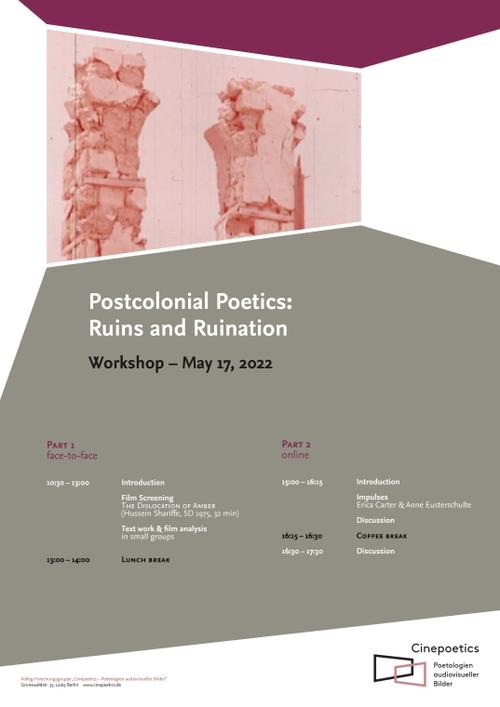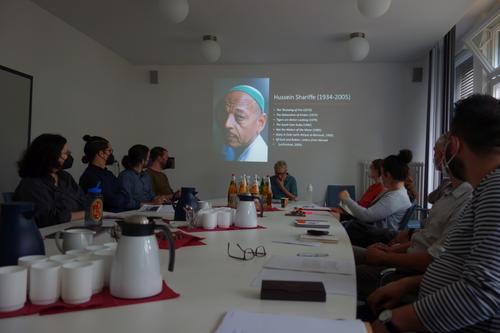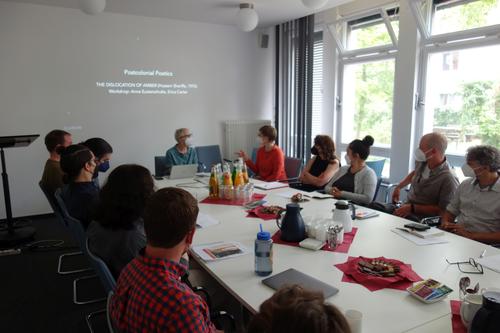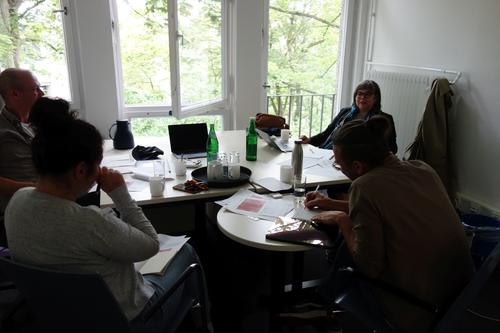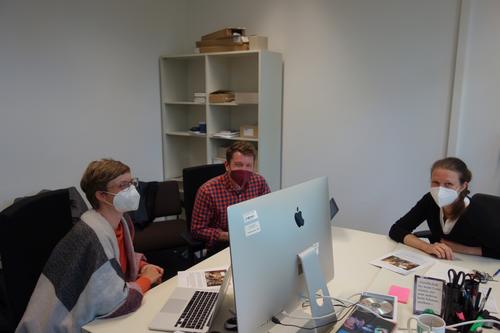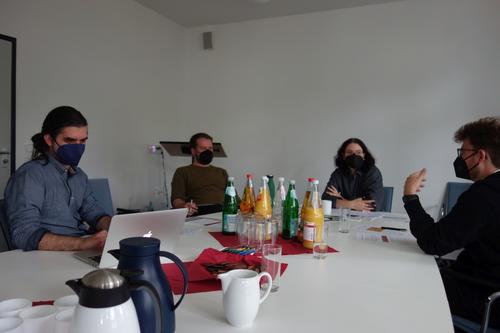Postcolonial Poetics: Ruins and Ruination
17.05.2022 | Hybrid Workshop by the Cinepoetics group with Erica Carter and Anne Eusterschulte.
Research Focus: Audiovisual Cultures
The full-day workshop aimed to discuss historicity and the concept of postcolonial ruination, focusing on Sudanese director Hussein Shariffe's THE DISLOCATION OF AMBER (1975) as well as the book "Imperial Debris" by Ann Laura Stoler. The day started with a short introduction and a screening of the film. Afterward, several groups were formed and provided with a collection of textual and visual materials to prompt reflection. In the afternoon, the discussion then moved to an online meeting where each group presented its findings.
The group "Ruins and Ruination: History and Nature" first prepared an inventory of nature in THE DISLOCATION OF AMBER. While the cosmic elements pervade the film and are visible in the erosion of the buildings, only a few animals and little vegetation are shown. The group thus observed a decoupling of the connection between vitality and movement. At the same time, vitality is present in the medium itself through camera movements and zooms. Countering linear and forward-directed actions, the regulated, reduced, and ceremonial movements in the film suggest an agency in crisis.
Participants of the group "Political Aesthetic Perspectives: Ruination and Time" focused primarily on the soundscape of the film. An interlacing of the rhythms of wind, water, chants, and bird calls established a sense of overlapping time located between stasis and movement. The strong sense of circularity suggested ruination as an ongoing force, and the play with depth and layering of time indicated a sense of a present pastness. Furthermore, the group explored the placement of persons in the film, who appear as inhabitants and ghosts at the same time. In this remembrance of past trauma, colonial history appeared in and as a ghostly or dreamlike atmosphere.
In their findings, the group "Symbols, Metaphors, Allegories" noted that as soon as one assigns a specific meaning to an event, one gets trapped in the amber of the film’s title. The different ways of looking in the film don’t allow for a subjective view that leads to examinable metaphors. The participants also described the interwoven symbols as transitional between matter and metaphor, infrastructure and image, which created a filmic fabric with an ornamental quality. Another aspect the group discussed was gender as seen in the metaphoric colonial conquering of the female body. Finally, the specific color scheme of the film brought up the question of preservation.
"Ruination, Debris, Rot," the fourth group, described the soundtrack as crucial in the creation of a space of emptiness. With past and future present at the same time, the ruins can be seen as places where life is to be imagined. They noted the transitoriness of convention, as the ruins transform into landscapes and dissolve the limits of nature and culture. The group noted that the multitude of perspectives in the film leads to a deeper absorption into the layered pasts. They also addressed the purposeful ethical horizon of acknowledging the past and its environmental and social consequences. In closing, they pointed out that the film draws the spectator's attention, while at the same time paralyzing them.
The fifth group, "Construction-Symbols, Meanings, Montage," found a meditation on the idea of fragmentation in pans, zooms, and the oscillation between short bursts and long shots. Following this, the film may be interested in gaps, which are then filled in with rubble aligned with subjects. They noticed the presence of ambivalently competing ideas of history – the melancholic contemplation of imperial debris on the one hand, and the fragments and parts of rubble associated with the fragmentary subjectivity of the colonial subject on the other. Importantly, they noted that the viewing subject also becomes fragmentary and goes through a constant process of becoming.
In the last part of the workshop, Erica Carter gave a short presentation of the collaborative project with the Sudan Film Factory, the Arsenal – Institut für Film und Videokunst e.V., the Husein Shariffe's family, and King's College London which aims to reassemble the oeuvre of the exile filmmaker in an open-source digital archive. After this introduction, Carter reflected on the possibilities of incompleteness, debris and assemblage, and archival futures. She noted that Shariffe's unfinished film OF DUST AND RUBIES not only resists closure but also underlines the disciplinary force of narrative conventions. For Shariffe, as well as for other exiled filmmakers, it becomes a historical and political issue. Moving on, Carter posed the question of how to recognize the conditions of violence and political suppression that produce states of incompletion and fragmentation. Following this, Carter mentioned a set of different media practices surrounding the making of THE DISLOCATION OF AMBER and broadened the topic to film's relationship to tangible matter, the environments in which film circulates, and the overall notion of film as an assemblage. This also included giving insights into the working processes of the archival project. Carter cautioned to keep in mind the effects of organizing data in a classification system, which is a form of epistemological regulation. In closing, she indicated that a film might be unfinished in the sense of its situatedness, leaving gaps to be filled with interactions by the spectators.
Christina Schmitt, Eric Ritter, and Cilli Pogodda
Jaspar Stratil, Lars Dolkemeyer, Tereza Nekulová, and Björn Hochschild
In her impulse presentation, Anne Eusterschulte gave a historical outline of the location of the film, the city of Suakin. This island used to be a crossroad of trade routes, pilgrimages, and cultural settlements. This hybridization of traditions becomes visible in the film. While Suakin was repeatedly subjugated and occupied by different forces, it was also a flourishing location that was continually rebuilt. However, not only colonial history but also natural forces and economic marginalization brought Suakin to ruins. Eusterschulte then added some considerations on the topics of natural history and allegory in the film. She pointed out that in the 20th century, natural history did not assume a dichotomy of nature and culture but rather saw them as merging and interconnected. In the film, nature acts as a scripture of history and the multiperspectivity of viewing creates a landscape of ruins. Natural history, thus, invokes a processual meaning and allows cultural patterns of the past to proliferate into the present. The second point Eusterschulte brought up concerned the notion of allegory. If the allegory is expressed by a certain fragmentarization, the artwork can be interpreted as a process of ruination by montage. The multiperspectivity in the film evokes various possible narratives, with different time levels crossing each other. Thus, while an event has not yet passed, it already continues into the present.


